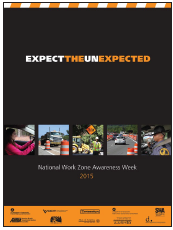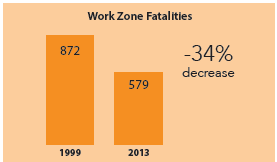2015 National Work Zone Awareness Week
Printable version [PDF 456KB]
You may need the Adobe® Reader® to view the PDFs on this page.
March 23-27, 2015
EXPECT THE UNEXPECTED
The 2015 National Work Zone Awareness Week will be held March 23-27, 2015, with the theme of "Expect the Unexpected." National Work Zone Awareness Week (NWZAW) began in 1999 when the Federal Highway Administration (FHWA), the American Traffic Safety Services Association (ATSSA), and the American Association of State Highway and Transportation Officials (AASHTO) signed a Memorandum of Agreement (MOA) pledging to increase public awareness of work zone safety issues through a media campaign. In 2000 it became a national event, and awareness has continued to grow, with the majority of State agencies and many other organizations sponsoring high-visibility education and outreach initiatives.
Expect the Unexpected: What Does This Year's Theme Mean?

Driving in and around work zones requires motorists to constantly be alert and be prepared for changes - normal speed limits may be reduced, traffic lanes may be closed, narrowed, or shifted, and people may be working on or near the road.
Many drivers would be surprised to find out that most work zone fatalities – approximately 81% in 2013 – are drivers and passengers of vehicles, and the other 19% are other non-motorized users such as pedestrians and bicyclists. In 2013, the most recent year for which data are available, speeding was a factor in 23 percent of fatal work zone crashes. Two out of three victims in work zone crashes in 2013 were drivers and their passengers. The driver plays a key role in making work zones safer for everyone, especially themselves.
Driver-related factors that affect work zone crashes include speeding, distractions (such as cell phones, texting, and radios), inattentive driving, and aggressive driving. The main type of work zone crash is a rear-end collision, and adequate following distance is important in avoiding such crashes.
As highlighted by this year's theme, drivers must be prepared to expect the unexpected. The presence of trucks (including construction vehicles), flaggers, queues, and reduction in speed limits in work zones all create an environment where being prepared and alert is critical. When motorists are alert, obey traffic control devices (e.g. signs and pavement markings), maintain the posted speed limit, and pay attention to traffic patterns, the safety of everyone is enhanced.
Expecting the unexpected applies to workers as well. The leading cause of highway construction worker injuries and fatalities is contact with construction vehicles, objects, and equipment. These injuries and deaths are preventable through a number of good practices.
How Is FHWA Helping To Create Safer Work Zones and Minimize the Unexpected?
As an agency dedicated to safe and efficient surface transportation, FHWA is dedicated to reducing congestion and crashes in work zones. Consequently, the safe and efficient flow of traffic through work zones is a major concern. While we address congestion in work zones, we can help improve safety as well. Smoother traffic flow through work zones can lead to enhanced worker safety, fewer rear-end crashes, less frustrated drivers that drive more safely, and quicker project completion.
FHWA is actively pursuing improved work zone safety and mobility through a multi-faceted approach of better engineering, education, enforcement, increased coordination with public safety agencies (police, fire, and emergency medical service), and regulation. FHWA also partners with a variety of organizations that are interested in improving work zone safety and mobility.
FHWA develops and provides a broad array of guidelines and training, conducts research, implements regulatory changes, and works continuously to increase public awareness through partnering activities. Research, guidance, and training in the areas of intelligent transportation systems, project coordination, work zone design and engineering, traffic analysis, and traffic management can help State Departments of Transportation and other agencies plan and design safer, more efficient work zones, and provide motorists with advance information to help them better prepare for driving through work zones.
Work Zone Fatalities Continue To Decline: Some Statistics*

Source: National Work Zone Safety Information Clearinghouse, http://www.workzonesafety.org/crash_data/
The increased focus on work zone safety and mobility by FHWA, State Departments of Transportation, and other agencies and organizations seems to be working. Work Zone fatalities have decreased by 34 percent since 1999.
In 2013 (the most recent available data) there were:
- 579 work zone traffic-related fatalities (6% decrease from 2012)
- 29,000 work zone injuries (9% decrease from 2012)
- 105 worker fatalities (21% decrease from 2012)
- 186 large trucks (184) and buses (2) involved in fatal crashes in work zones (11% increase from 2012)
However, there is still work to be done and FHWA and its partner agencies must continue to focus on developing resources, tools, and countermeasures to help prepare motorists for the unexpected, and overall, to create more efficient and safer work zones.
*Source: FARS: http://www.nhtsa.gov/FARS, NIOSH: http://www.cdc.gov/niosh/topics/highwayworkzones/
Making Work Zones Work Better
